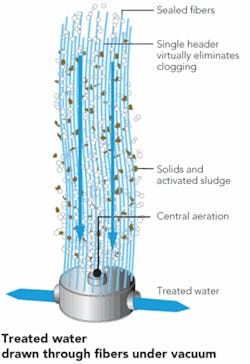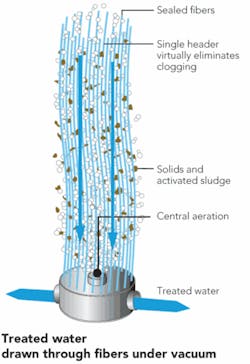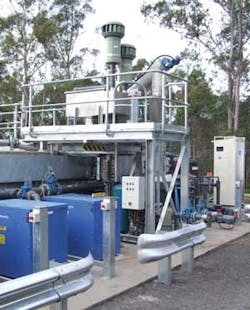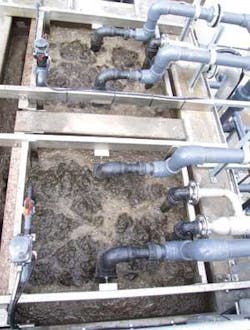MBR Systems Provide Wastewater Reclamation In Rural Australia
By Antonia von Gottberg, Darren Lawrence and Christoph Kullmann
Membrane bioreactors (MBR) with submerged membrane modules have set the standard for the next generation of biological wastewater treatment plants as they offer two main advantages; a significantly improved effluent quality and a substantially smaller footprint. Besides the huge application in industrial wastewater treatment there are many municipal applications where MBR technology is being implemented. An example is the Bega Valley Sewerage Program (BWSP) in Australia which includes state-of-the-art MBR plants.
Bega Valley is located on the southeastern coastline of New South Wales (NSW). It includes the towns of Cobargo, Wolumla, Kalaru and Candelo. The capacity of the valley’s wastewater treatment systems was being stretched by urban growth and by seasonal population increases during the holiday period. Some unsewered villages in the valley were at risk for environmental and public health issues caused by discharge from septic tanks.
In order to maintain Australia’s Environment Protection Authority compliance and to enhance environmental outcomes, the Bega Valley Shire Council developed the Bega Valley Sewerage Program, which includes the installation of new pressurized sewage collection systems coupled with membrane bioreactor (MBR) treatment plants in the towns of Cobargo, Wolumla, Kalaru and Candelo (BVSP, 2004–2006). The Cobargo MBR plant was commissioned in July 2006 and Wolumla and Candelo were commissioned in 2007. Kalaru will follow sometime in 2008.
The entire program is designed to keep capital and operating costs at a minimum and to produce a very high quality effluent for reuse. Reclaimed water from the MBR plants will be used in an irrigation scheme on public facilities, replacing potable water as the primary source. In future, reclaimed water may also be used for toilet flushing and to provide a vehicle wash down facility.
Example of MBR Technology
There are many different configurations of MBR technology. One example that optimizes both membrane and module design is the PURON™ submerged hollow fiber UF module from the authors’ company. The patented module is designed to avoid the clogging and sludging that is an issue with some MBR module designs offered today. The module features hollow fiber membranes with a pore size of approximately 0.05 micron. The lower ends of the membrane fibers are fixed in a header while the upper ends are individually sealed and are free to move laterally. All solids and particulates remain on the outside of the fibers while permeate is sucked out of the inside of the fibers by means of a vacuum.
The fibers are arranged in bundles and are submerged vertically into the activated sludge. To maintain the filtration rate of the membrane modules, air scouring is carried out at regular intervals. An air nozzle is integrated into the center of the bundles to apply the air for scouring purposes. The central arrangement of the air nozzles inside the membrane bundles reduces the energy consumption, since the air is injected at the place where the risk of sludging is highest. The module design ensures that even hairs and fibrous compounds will be removed reliably from the system, so that a coarse prescreen can be used, thus improving capital and operating costs. A special feature of these membranes is their enormous mechanical strength. This mechanical strength is provided by a braid inside the membrane material.
The individual fiber bundles are connected in rows. Several of the rows are mounted into a frame made of stainless steel to form a module. The free moving fibers combined with central aeration ensure stable filtration during plant operation, long membrane life, and low operating costs by reducing the need for energy, cleaning and maintenance.
Bega Valley Sewerage Program
The Bega Valley Sewerage Program is an alliance formed between Tenix Alliance and the Bega Valley Shire Council to upgrade five existing sewage treatment plants and install greenfield sewerage systems for five villages in the region (Stone, 2005). The program includes updating the existing plants to Biological Nutrient Removal (BNR) facilities and installing new pressurized sewage collection systems coupled with membrane bioreactor (MBR) treatment plants in the towns of Cobargo, Wolumla, Kalaru and Candelo. The program also includes the operations and maintenance of the new and existing sewage treatment plants for 10 years, with an option for council to extend the agreement for a further five years. All collection systems will remain the responsibility of council.
Bega Valley MBR Plants
The four MBR systems are identical, resulting in significant cost savings for the Bega Valley Shire Council and the community. Each system is designed for 800 people equivalents or an annual average flow of 180 m³/day (47,000 gpd). The maximum daily flow is 300 m³/day (80,000 gpd) and the peak hourly flow is 360 m³/day (95,000 gpd).
Each plant includes prescreening with 3 mm perforated plate screens followed by a biological treatment system with nitrification and denitrification. The UF membranes are submerged in the mixed liquor and used to separate the treated wastewater from the suspended solids. Each plant has a footprint of approximately 20 × 15 meters.
Conclusions
The MBR systems supplied as part of the Bega Valley Sewerage Program are helping several small communities to reduce the risk of environmental and public health issues related to discharge from septic systems. Additionally, the MBR effluent is high enough quality to be recycled, thus providing additional water resources to the communities.
The first MBR system at Cobargo has been running for more than a year, and two of the other three systems were commissioned in 2007, with only Kalaru yet to come on-line.
MBR systems are appropriate for many rural areas because they require minimal supervision, can be designed to blend into the landscape, and provide high quality effluent for recycling.
References
- Bega Valley Sewerage Program (BVSP), web site www.bvsp.com.au ©2004–2006.
- Howe, K. J., E. Livingston, A. T. Hanson, S. E. Cabaniss, B. M. Thomson, D. Chen. “Indirect Potable Reuse Using Membrane Bioreactors and Reverse Osmosis”, Proceedings, AWWA Membrane Technology Conference, March 18–21, 2007.
- Stone, W., C. Truscott, and D. Searle. “Alliance Project Delivery – Bega Valley Sewerage Program Background” Water Journal, Australian Water Association. December 2005.
About the Authors:
- Antonia von Gottberg, Koch Membrane Systems, Wilmington, MA
- Darren Lawrence, Koch Membrane Systems, Aachen, Germany
- Christoph Kullmann, Koch Membrane Systems, Aachen, Germany



